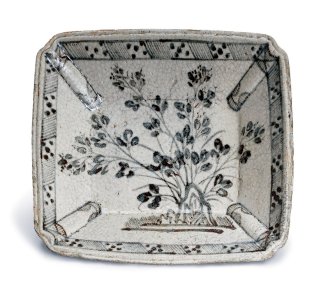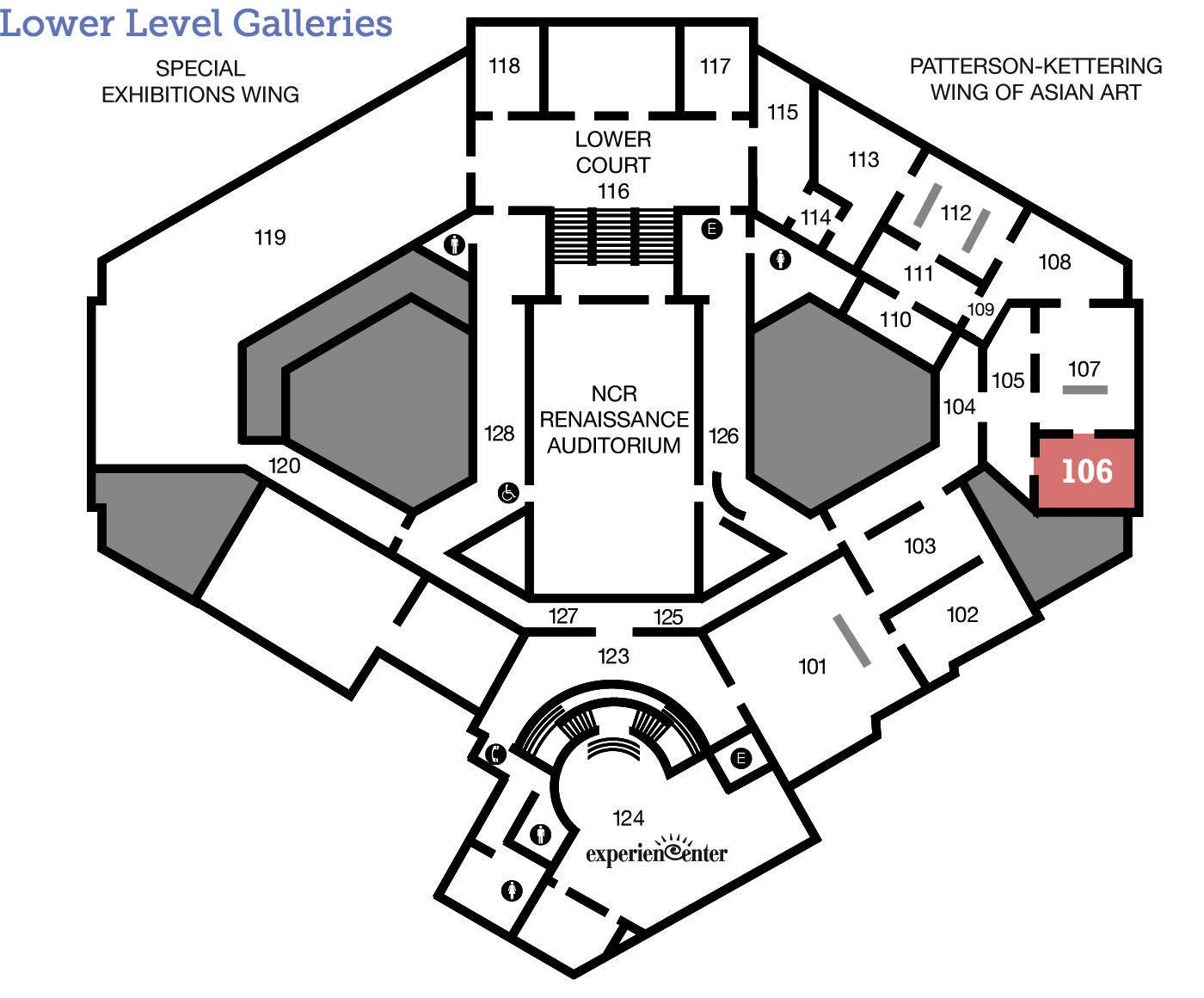
Japanese
Dish with Foliage Design, or Footed Dish
Japanese Stoneware with underglaze iron decoration 9 3/8 x 8 x 2 ¼ inches Gift of Mrs. Virginia Kettering 1969.16 Mino ware footed dish, Momoyama period
Imperfect Beauty
What does beauty look like? Is it shiny and colorful? Perfectly symmetrical? In the midst of great social change in the late 1500s and early 1600s, masters of the tea ceremony cultivated an appreciation for a concept of beauty that may surprise and will certainly delight.
A Day in the Life
The Art of Making Tea
This dish was made specifically to be used in chanoyu (the way of tea), often referred to as the tea ceremony. In the 16th century in Japan, chanoyu grew in popularity and sophistication, and is still practiced today. On the one hand, it is simply making a cup of green tea for guests; on the other, it is a profound exercise of aesthetic, moral, and even spiritual sensitivity. What exactly is the tea ceremony and how did it develop? Find out in the following video from the Asian Art Museum.
© 2014 Asian Art Museum Chong-Moon Lee Center for Asian Art and Culture
Transcript Summary:
The way of tea goes back at least 800 years. Tea was first imported from China and Korea. At first, it was valued for its health benefits. In the 13th and 14th centuries, the political and military elite drank tea in elaborate settings with luxury Chinese goods. During the 1500s, a series of tea masters developed a different approach that came to be known as chanoyu, the way of tea (literally “hot water for tea”). They used simple dishes and utensils in unpretentious settings. Small groups gathered for a single meal, tea, and a time for appreciating calligraphy, poetry, and other decorative arts. The host would plan an event long in advance, choosing the appropriate utensils and decoration for the season and theme, creating a singular experience. Chanoyu supported the development of other arts, including calligraphy, basketry, and pottery. Some samurai warriors were practitioners of the way of tea, including the famous military leader Hideyoshi.
The way of tea is still practiced today by different schools, but they share the similar values of harmony, respect, purity, and tranquility. Also, artisans continue to make refined products for use today. Chanoyu is an art that engages all the senses and is a window onto traditional Japanese culture.
Tools and Techniques
Behind the Scenes
Look Closer
Perfect Imperfection
This dish is an example of Mino ceramics, which come from the area of Mino near present-day Nagoya in central Japan. It is a particular type called Shino, which uses a unique feldspathic glaze. In the case of this dish, the design was painted onto the clay with an iron slip and then it was glazed and fired. Look closer at this dish, including from the side, and notice the uneven shape and glaze—there are even areas that are unglazed, such as the orange spots along the edges.
These are not flaws or mistakes; rather, certain tea masters worked with Mino potters to create objects with these features. As the tea ceremony developed in the 16th century, a specific style emerged that contrasted with the typical use of luxury Chinese objects. This was the wabi tea ceremony, particularly associated with the greatest tea master, Sen no Rikyū (1522–1591). This form of tea ceremony placed a high value on mundane, misshapen, or even broken implements for expressing wabi, a form of beauty marked by simplicity, imperfection, and austerity. By contemplating such beauty one could attain a sense of peace and equanimity in a constantly changing world.
Just for Kids
Create!
When you drink tea what kind of dishes do you use? Do you use a big mug or small tea cup? In 16th-century Japan, this dish was used for tea ceremonies. During this ceremony people met, drank tea, and talked about art and poetry.
Sculpt your own dish using clay like Crayola Model Magic. Knead the clay and press a layer of clay until it is half an inch thick. Form the clay to the shape you want. After you have finished sculpting, decorate your dish by adding extra clay, carving a design, or adding color with paint or markers.
Signs & Symbols
Dig Deeper
A Peachy Time
This dish was made during the Momoyama period (1573-1615). It was a brief time of intense political change. The Ashikaga shogunate that had been in power for over 150 years was ousted, attempts were made to unify the country, and there was increased contact with European traders and missionaries. At the center of this was the brilliant military leader Toyotomi Hideyoshi (1537-1598), a pivotal figure in Japanese history. The name of the period—Momoyama—means “peach blossom hill” and comes from the many peach trees that were planted on the site of Hideyoshi’s castle after it was torn down. The following questions contain true facts about Hideyoshi's life, but also some false ones. Try to find the correct ones!
1. By 1585 Hideyoshi was the most powerful man in Japan. What was unusual about his background?
He was an orphan.
He started his military life as a common foot-soldier.
He grew up in Mongolia.
2. Hideyoshi was extremely ambitious. After unifying most of Japan, he invaded which country?
Korea.
Russia.
China.
3. Hideyoshi was a great patron of the arts, including the tea ceremony. In fact, the great tea master Sen no Rikyū was a close advisor. Hideyoshi famously ordered Rikyū to do what?
Spit in a cup of tea made for a rival general.
Walk barefoot from Tokyo to Osaka shouting, “Hideyoshi is king!”
Commit ritual suicide.
Arts Intersected
Read a poem, write a poem!
When trying to express the essence of the tea ceremony, tea masters would often quote famous poems from hundreds of years earlier. For example, the following two poems were favorites of the tea masters Sen no Rikyū and Takeno Jōō.
To those who wait
Only for flowers,
Show them a sprig
Of grass amid the snow
In a mountain village.Fujiwara no Ietaka
Translation in Haga Koshiro, “The Wabi Aesthetic through the Ages,” trans. Martin Collcutt, in Japanese Aesthetics and Culture: A Reader, ed. Nancy G. Hume (Albany: State University of New York Press, 1995), 245–278.
Gaze out far enough
Beyond all cherry blossoms
And scarlet maples,
To those huts by the harbor
Fading in the autumn dusk.Fujiwara no Teika
Translation in William F. LaFleur, The Karma of Words: Buddhism and the Literary Arts in Medieval Japan (Berkeley: University of California Press, 1983)./p>
Both of these poems express the aesthetic of wabi, an appreciation for the simple, unpretentious, and even imperfect. The DAI’s dish captures this both in its shape, color, and finish, and also in the clump of plain autumn grass painted on the surface.
These poems are examples of waka. You may be familiar with haiku, a 17-syllable poem of 5, 7, and 5 syllables per line. Haiku developed out of waka, a much older poetic form. There are 5 lines, with lines of 5, 7, 5, 7, and 7 syllables. Like haiku, waka creates a kind of rich emotion through an impersonal description of nature. Try to create your own waka in the box below!
Total Syllables:
The Sculpture Speaks
Did You Know?
Expert Opinion
Look Around
About the Artist
Talk Back
Nobody is Perfect
This dish is the product of an aesthetic movement that looked for beauty in worn, misshapen, and old things. Craftsmen within this movement created new objects that evoked these qualities, pursuing a kind of perfect imperfection. A masterpiece is often thought of as a work that is perfect, or near-perfect. How might this dish modify your understanding of perfection, both in a work of art and also in life?

